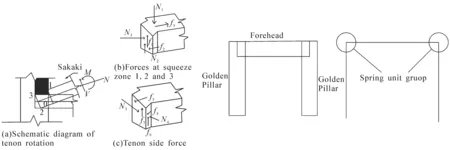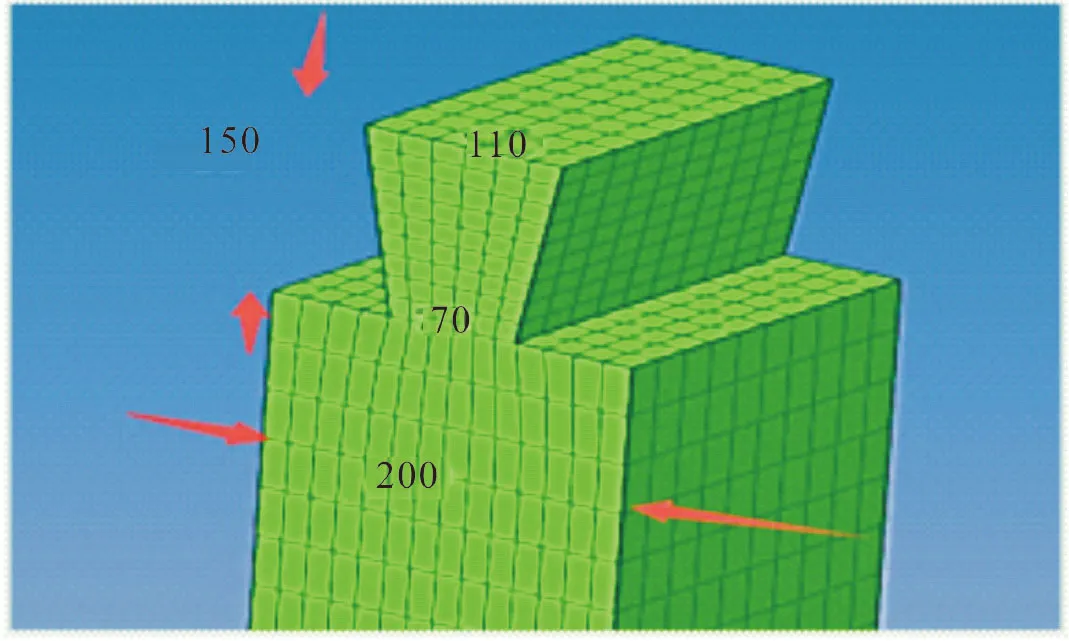Analysis of Special Structure of Song-Style Second Grade Dovetail Tenon*
2021-12-21WANGJianxingGAORuxinYANGDuanHEJiaxin
WANG Jianxing, GAO Ruxin,2, YANG Duan, HE Jiaxin
(1.School of Civil Engineering, North China University of Technology, Beijing 100144, China; 2.Agricultural Service Center, People's Government of Beiqijia Town, Changping District, Beijing 102209, China)
Abstract:To better analyze the mechanical properties of the dovetail tenon structure, a twofold line multi-parametric mechanical structure was established, and a mechanical analysis test suitable for wooden structures was carried out. Then, the corresponding dovetail joints were proposed based on the mechanical balance and a deformation coordination relationship formula. The above research results show that the deformation of the dovetail tenon is mainly concentrated around the contact between the tenon and mouth. When the unidirectional load becomes larger, its bending moment also becomes larger, which is easy to cause damage to the contact surface. The load-displacement curve and the ultimate load-vertical load curve obtained through the test also show that when the vertical load increases, the ultimate load also increases; when the ultimate load reaches the yield critical point, the increase in displacement becomes smaller and tends to be smooth.
Key words:Song-style wood structure; dovetail tenon; force transmission mechanism; mechanical property
The tenon and tenon structure is a way of interconnecting the various components in the woody component[1]. Among them, the dovetail tenon is in the shape of a trapezoid. The tenon and mouth are used to insert the square material so that the corners are tightly combined and can avoid separation under tension. It is widely used in ancient architectural wooden structures.
Scholars at home and abroad have done a lot of research on the mechanical properties of the tenon and mortise structure from different aspects. In terms of experimental research, Xu et al.[2]conducted a pseudo-static test on the reduced-scale model of the dovetail column frame. The results show that the dovetail joint has strong consumables and deformability. Gao et al.[3]conducted a pseudo-static loading test to study the effect of friction coefficient on the hysteretic performance of dovetail joints. Thomas et al.[4]verified the force of the full-scale dovetail joints in the quasi-static compression zone and investigated the effect of the height of the tenon and the angle of retraction on the hysteretic performance. In terms of numerical simulation, Kang et al.[5]performed low-cycle reciprocating numerical simulations on dovetail members with gaps and explored the hysteretic performance of damaged dovetail joints under horizontal loads. Villar et al.[6]carried out a numerical simulation on the connection of nodes between wooden frames and pointed out that the friction between nodes on the seismic performance of the structure is affected by the rotation of the tenon and the force on the side of the tenon.
Taking the dovetail joint as the research object, the influence of the size and wood performance on it is determined through a single load test combined with numerical simulation. The dovetail multi-parameter mechanical model and calculation formula of the dovetail tenon are established and compared with the experimental conclusions to verify the universality of the established model.
1 Dovetail Joint Force Transmission Mechanism
Normally, the tenon and tenon structure bear the load transmission between the supporting roof beams and the wooden structure roof. The dovetail tenon and tenon structure are subject to certain pressure and tension between the gold pillar, the eave pillar, and the upper forehead. At the same time, its nodes have rotational stiffness, can transmit bending moments, and have obvious semirigid characteristics.
According to the literature[7], it can be seen that the wood at tenon is mainly compressed by the transverse grain, and mouth is mainly compressed by the grain, and the elastic modulus of the wood's transverse grain is much smaller than the modulus of the grain, so the compression deformation of the tenon is large. The size of the mouth does not change basically, and as the corner continues to increase, the tenon deforms irreversibly. Under the action of a load, when the tenon rotates around the origin to produce a corner, an embedding effect will occur between the tenon and the mouth, resulting in extrusion zones 1, 2, 3, as is shown in fig. 1(a). Positive pressuresN1,N2, andN3are generated on the top, bottom, and ends to generate the corresponding frictional forcesf1,f2,f3, see fig. 1(b). There will be positive pressuresN4andN5on the side of the tenon and the inner side of the mouth, which will cause the spread of the mouth to produce friction forcesf4,f5,f6,f7, as shown in fig. 1(c).

Fig. 1 Simplified Diagram of Dovetail Tenon Stress
2 Theoretical Analysis of Dovetail Tenon
The dovetail joint is mainly subjected to a shearing force and is also affected by the combined force of bending moment and axial force[8], and its failure mode is shearing of the tenon or expansion and cracking of the mouth. Compared with the joints of concrete and steel, the deformation of the tenon and mortise joints of wood structures is more obvious[9].
The force process of the dovetail joint will be divided into two stages[10]. In the first stage, the upper and lower squeezed areas of the tenon are in the elastic stage. Assuming that the yield angle of the dovetail joint isθy, when 0<θ≤θy, the vertical forceNof the column end is balanced by the reaction forceN0of the column end and the reaction forceN1generated by the upper tenon extrusion, and the balance can be obtained in the equation,
(1)
According to the geometric relationship,
L=d+y+(1-cosθ)l+(h-ysinθ)sinθ.
(2)
According to the deformation coordination relationship,
(3)
Combining formulas (1)~(3)N1can be calculated,
In the second stage, as the rotation angle continues to increase, the compression deformation of the tenon continues to increase. Whenθu≥θ>θy(θis the limit rotation angle of the node), the extrusion zone enters the plastic stage, andN1is calculated using the embedded amount of the tenon,
Assuming that the wood is anisotropic material, and the elastic modulus of the wood under tension and compression is equal, the twofold line constitutive model is adopted for the compression of the parallel and horizontal grains. When the final joint is turned into the normal position, theM-θcalculation formula of the dovetail joint is expressed as,
3 Unidirectional Loading Model Test and Unidirectional Loading Simulation Test
In the unidirectional loading simulation test, three displacement meters are arranged on the beam to measure its horizontal and vertical displacement. Its purpose is to simulate the force form of the actual structure. The graded load of the unidirectional loading method should be less than 1/10 of the estimated horizontal ultimate bearing capacity or the maximum test load. After each level of load is applied, the horizontal displacement can be measured after the dead load, and then unloaded to zero, the residual horizontal displacement is measured. The test shall not be paused in between.
Corresponding resistance strain gauge is set at the two ends of the forehead, the root of the tenon, and the upper and lower positions of the column to measure the deformation of the cross-section at the corresponding position. The column and the forehead are connected by a tenon and tenon joint, and a concentrated load acts on it. During the test, the I-beam is applied by a vertical hydraulic jack that can move horizontally and synchronously[11], and the loading amplitude is 2.5 mm/min. At the beginning of the test, a constant vertical load was applied to the column head through the I-beam load sharing beam. Then a horizontal load is applied, the tenon and tenon joints are deformed, the contact surface is tightened, and the connection stiffness is increased (fig. 2). As the vertical load increases, the lateral displacement of the wooden frame increases. When the limit load value is reached and the load is controlled by displacement, the squeezing degree of the contact surface between the tenon and mouth will increase, and the occlusion will become loose. Eventually, at the mortise and mortise extrusion surface, the wood yields plastically deform, loses its continued bearing capacity, the mortise and tenon connection fails, and the structure is damaged. According to the relationship curve between the vertical load and the ultimate load (fig. 3), it can be seen that if the vertical load of 100 kN is taken and gradually increased, the ultimate load will also increase linearly until the joint is completely yielded, that is, the tenon is seriously damaged.

Fig. 2 Curve of Relationship Between Vertical Load and Ultimate Load Fig. 3 Curve of Relationship Between Load and Displacement

Fig. 4 Schematic Diagram of Size Model
According to the node load-displacement relationship curve (fig. 4), it can be seen that its ultimate load is 2.56 kN and its ultimate displacement is 59.7 mm. With the increase of the vertical load, the displacement also increases continuously in an oblique straight line. When the limit load is reached, the increase in displacement gradually decreases, showing a gentle state. When the ultimate load is exceeded, the structure is destroyed and the displacement decreases rapidly. Since there are inevitably some gaps between the tenon and mouth during the installation of the test piece, the interaction between the tenon and mouth of the test mode is mainly due to the tightness of the gap during the initial loading stage. With the continuous increase of the horizontal displacement, the wood embedding occurs. At this time, the interaction between the tenon and mouth turns into a frictional slip, and at the same time, a slight "squeaking" sound can be heard. As the horizontal displacement continues to increase, the noise of the node becomes louder and louder. Later, the dovetail joints deformed irreversibly.
4 Numerical Model of Dovetail Tenon
According to the research results of the literature, it can be seen that the gap has little effect on the force performance of dovetail joints, and the wood discreteness is large, so the mechanical model of dovetail tenon to be constructed is composed of elastic section and yield section. To simplify the calculation, the following assumptions are put forward: First, the failure of the joint only occurs at the joint of tenon and tenon, without considering the bending deformation of the forehead and column. Second, when the joint is rotating, the mouth is compressed along the grain, and the tenon is compressed by the horizontal grain. The elastic modulus of the wood along the grain should be considered, and the stress-strain relationship should conform to Hooke's law. Third, ignore the influence of factors such as wood type, moisture content, and roughness of the contact surface on the friction coefficient between the woods, and take a fixed value of 0.1 for calculation[12].
4.1 Model Size and Material Parameters
The "material division system" in the construction method is a set of the most typical architectural modular system standards, which can play a role in regulating the size of each wooden structure[13]. The Song-style wood structure used in the model should follow the principle of "two materials and two contracts". A second-grade square column was selected as the modeling standard, and the dovetail tenon length, tenon width, and tenon diameter width were selected as 12, 15, 12 points; the diameter of the tip is 500 mm, the contact length with the square body is 400 mm, the width is 300 mm; the size of the mouth is 110 mm wide, 70 mm long and 150 mm high.
The wood material used for the model is Pinus sylvestris, which has the characteristics of good material, straight grain, strong adaptability, and excellent stress resistance[14]. Refer to tables 1, 2 for its elastic engineering consultants.

Table 1 Elastic Modulus of Pinus Sylvestris

Table 2 Plastic Parameter Table of Pinus Sylvestris MPa
4.2 Model Boundary Conditions and Friction Coefficient
Determination is based on the characteristics of Song-style wooden structure dovetail joints. In the modeling, the top part of the column isX,Zdirection displacement constraint, andZdirection rotation constraint, and the column foot is subjected toX,Y,Zdirection displacement constraint andY,Zdirection rotation constraint, until the displacement and rotation angle is 0. Normally, there are three nonlinear forms of friction contact with the tenon-and-mortise structure[15]. In the test, the friction contact of the dovetail joint only involves the contact area of the tenon and mouth and the position change during loading. The contact surfaces cannot invade each other, and can only transmit friction in the tangential direction. There is no tension on the normal line, only pressure, so that the tenon and mouth are completely attached. The friction model generated by the contact surface under the tangential action is selected as the penalty function model so that the connected contact surfaces can slide relatively elastically, which is more in line with the node loading test state.
4.3 Model Mesh and Elements
In the finite element software ABAQUS, engineering constants are used to define the parameters of its elastic stage, and the potential function in the software ABAQUS is called, and the Hill yield criterion is adopted to set the yield stress ratio of the wood in each direction. At the same time, the mortise and tenon joints are all divided by C3DR mesh, which is a reduced integration unit, and the mesh is divided by a structured grid.
4.4 Results of the Finite Element
The model is designed according to the material division method of Song's "Building Method". The size of the dovetail model was designed, taking into account the nonlinear factors of the model, and the parameters were defined and processed, including boundary conditions, grid unit division, and the friction behavior of the contact surface between the tenon and mouth. Finally, the finite element model of the dovetail structure is obtained. This calculation model can be used in calculations of other dovetail structures, briefly adjusting different materials and changing the reduction coefficient to adapt to the expansion of the scope.
Then the ABUQS software is applied to calculate and analyze the stress of the finite element model (fig. 5), and the truss body is in the state of "high stress on both sides and small stress in the middle". Among them, the stress value around the tenon joint is the largest, with a value of 6.13 kN, which is mainly subjected to pressure, and the stress at the other positions is within the allowable range. The stress distribution in this form is easy to cause damage to the interface and the narrow and wide mouth.

Fig. 5 Model Stress Cloud Diagram
5 Conclusion
Using Pinus sylvestris wood as a material to study the mechanical properties of dovetail joints, through unidirectional loading tests, the ultimate load and displacement changes under uniform load conditions are obtained, and then the finite element ABAQUS software is applied to analyze the numerical model stress of the structure status. Experiments and numerical simulation studies show that there is a certain risk of damage to the contact surface between the dovetail head and the mouth. When the load exceeds the yield point, the rupture will occur. There is a linear relationship between vertical load and ultimate load in the test, and there is a nonlinear relationship between ultimate load and displacement. When the ultimate load reaches the highest peak, it will tend to be gentle. Therefore, when designing the tenon-and-mortise structure, the size effect of the tenon and mouth should be considered to avoid fracture. The theoretical calculated results are in good agreement with the existing test results, which can provide a reference for the force analysis of the wooden structure of ancient buildings. The dovetail joint model proposed in this paper has good universality and can provide a theoretical basis for the study of the seismic performance of ancient wooden structures and the repair and reinforcement. The theoretical calculation results are multiplied by a certain reduction coefficient before being applied to actual projects.
